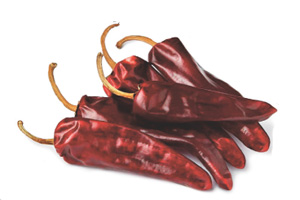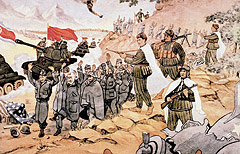The Mexica socio-political organisation (see inset) was led by a sovereign known as a tlatoani. Below the tlatoani was a caste of nobles, which included the members of the royal family, the chiefs of the calpullis (groups formed by families) and the soldiers. Further below was the group named macehualli, who were traders (pochtecas), peasants and craftsmen. At the bottom of this ladder were the servants (mayeques) and the slaves (tlatlacotin).
The main economic activities of the Mexicas were agriculture (with basic crops such as corn, chilli, cocoa, cotton, rubber etc.) and trade, managed by the powerful pochteca class.
Art and Architecture
Surely, these two forms of expression must have been much more present among the Aztecs than can be seen today, but the Spaniards’ gold fever, the brutal war of conquest and the Catholic eradication of idolatry razed a great part of the this civilization’s cultural heritage.
The Aztec style in art and architecture was determined by religious inspiration. Therefore, for example, with regards to architecture, which is only known by the ruins which have survived, their most representative constructions were the pyramid-temples. These, which followed Mayan construction traditions, featured a stepped structure, with a temple or group of temples of levelled tops (not pointed like the Egyptian pyramids). Regarding their cities, some features of the most important, Tenochtitlan, are known. Thus, according to Spanish chroniclers and the remains found of their Templo Mayor or Great Pyramid, it is known that the city had wide avenues, navigable canals, chinampas (see inset), a great market, several neighbourhoods and high pyramids. This was possibly the largest city in the world of its time.
The Aztecs were skilful sculptors and depicted religious symbolism in their works, such as «Coatlicue» (2.5 metres high) and the «Sun stone» (an Aztec calendar in bas-relief) or natural themes (animals, such as grasshoppers, coyotes etc.).
As craftspeople, the Aztecs also excelled in gold and silver work, with jewels and masks; weaving; mosaics; woodcarving and feather work (panaches, suits and shields of feathers from exotic birds). In painting the codices stand out (pictographic manuscripts made on animal skin, fabric and paper), which were made by expert scribes named tlacuiloani.
Religion
A great part of Aztec life and culture was determined by their religious beliefs, some of which they adopted from their neighbours or subdued peoples.
The Mexicas were polytheists, although a few main divinities predominated, related to the movement of the sun, farming and life and death. Among these the following stand out: Huitzilopochtli, the god of war and sun; Tlaloc, the god of rain and Quetzalcoatl, the god who created man, and god of writing, the calendar and the arts.
Likewise, human and animal sacrifice was one of the most characteristic aspects of Aztec religion. The significance of offering human blood (and, to a lesser extent, animal blood) was to appease the sun deities, to ensure the continuity of the Sun’s appearance every day, and in doing so, the permanence of life on Earth.
Science and Education
The Aztecs, like the Mayans, developed and perfected a calendar based on a version of the Olmec calendar (inherited by Mayans and Zapotecs, among other peoples). The Aztecs had two calendars, one was civil or solar and had 365 days, the other was mystic or divinatory and had 260 days (Tonalpahualili). The combination of the two produced cycles which lasted 52 years.
This nation was also prominent because of its empirical medicinal practices (or Ticiotl) and the use of medicinal plants, both certainly mixed with magic and shamanism.
Education was very strict, and began at a very young age. Men were led towards a military vocation. Thus, from a very young age, they were raised to be strong, and the use of corporal punishment was not uncommon, for example: scratching the child with cactus spines or making them smell vapour of burnt chilli. When the children turned 15, their teaching was entrusted to a temple or military school, in which values such as truth, justice, and duty etc., were instilled into them as were skills such as singing and dancing and knowledge of religion, history, mathematics, interpretation of the codices, among other subjects. Women were urged to mind their manners and carry out all the domestic chores (mince and prepare food, spin cotton etc.)








 Termina la Guerra de Corea
Termina la Guerra de Corea